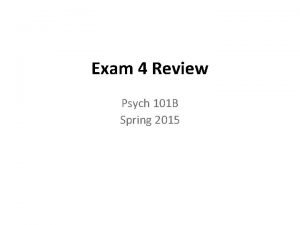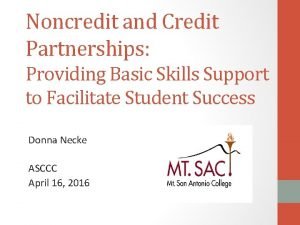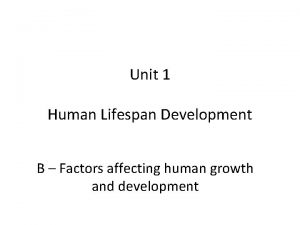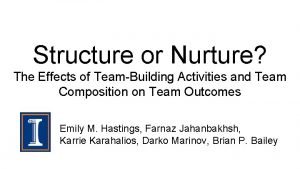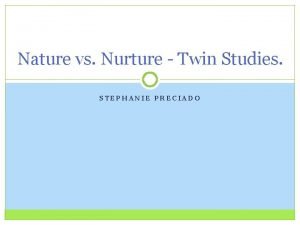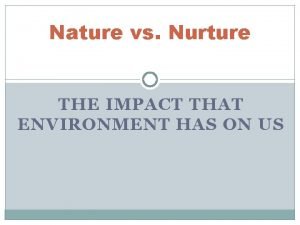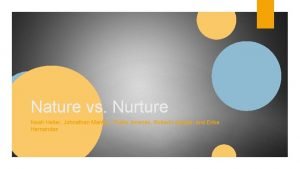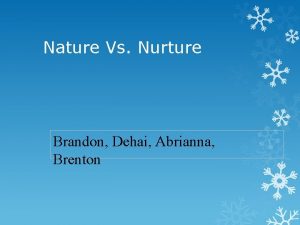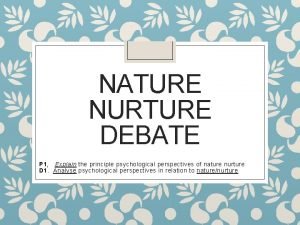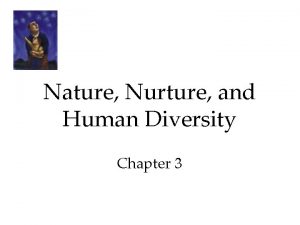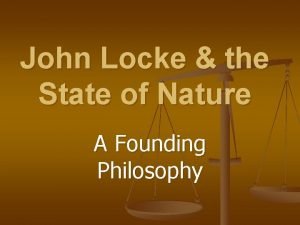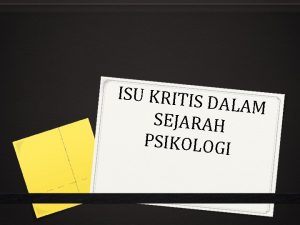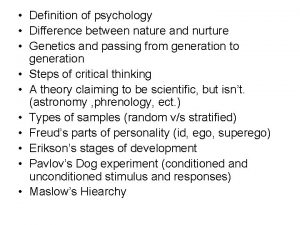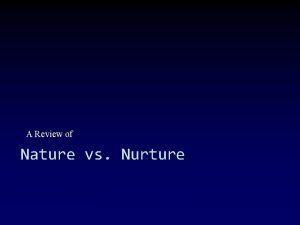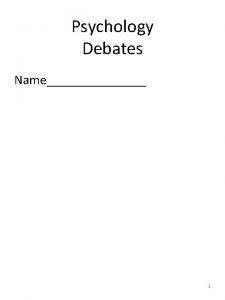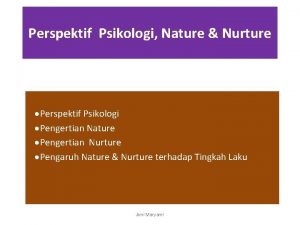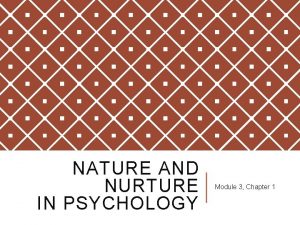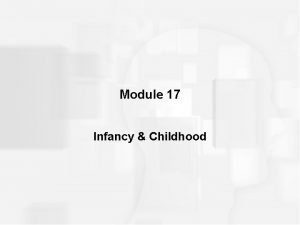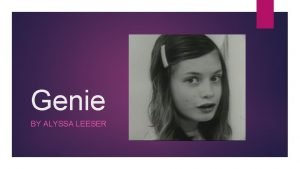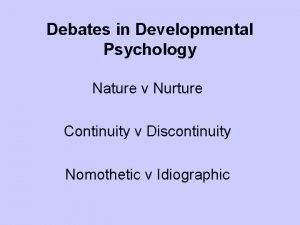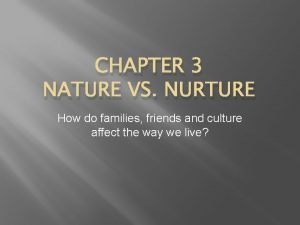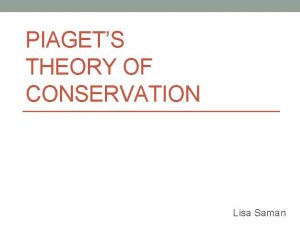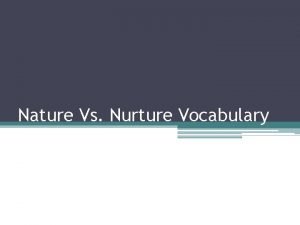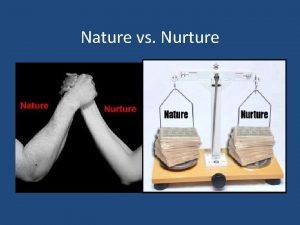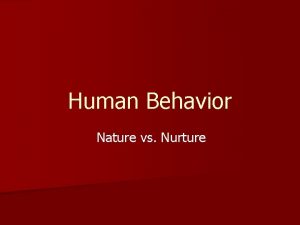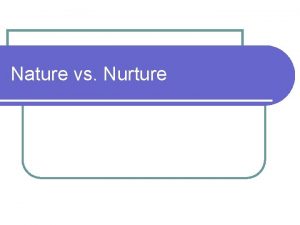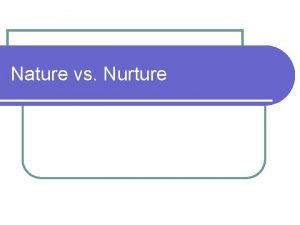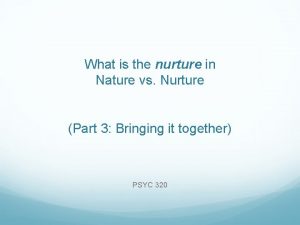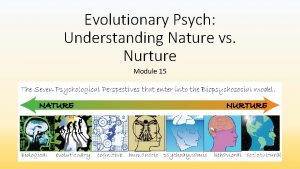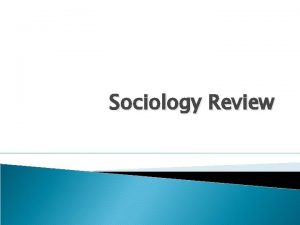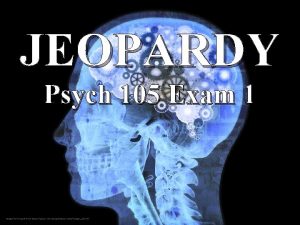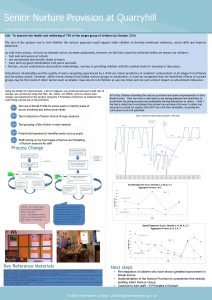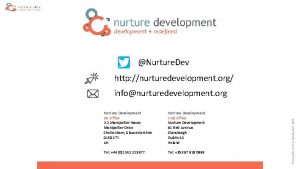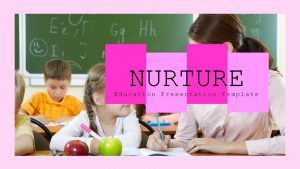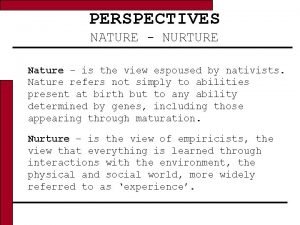AP Psych Exam Review 2015 Nature vs Nurture


























- Slides: 26

AP Psych Exam Review 2015

Nature vs. Nurture- twin studies

Methods of Research ● ● hindsight bias overconfidence intuition ethical principles ● hypothesis ● random selection ● random assignment o names from a hat! ● experimentation o IV o DV o control group o experimental group

Parts of the Brain Hemisphere Specialization ● ● Left vs. Right Corpus Callosum Fissure Split Brain Patients o Michael Gazzaniga

Parts of the Brain Cerebral Cortex (Upper Brain) ● ● Frontal lobe Parietal lobe Occipital lobe Temporal lobe o Motor cortex o Sensory cortex Association Areas: ❏ Frontal association area ❏ Prefrontal area ❏ Broca’s area ❏ Wernicke’s area

Parts of the Brain Forebrain Midbrain Hindbrain

Parts of the Brain ● Brain Stem o midbrain and hindbrain ● Midbrain o reticular formation ● Hindbrain o medulla o reticular formation o cerebellum o pons ● Forebrain o cerebral cortex o hypothalamus o limbic system

Brain Imaging Techniques 1. 2. 3. 4. 5. EEG CT scan PET scan- glucose! MRI f. MRI 4. 1. 2. 3.

Neurons and Neurotransmitters ● Agonist ● Antagonist ● ● ● ● resting potential depolarization threshold action potential repolarization absolute refractory period hyperpolarization

Nervous Systems ● Central o brain o spinal cord ● Peripheral o Everything else! § S. A. M. E. o Autonomic § sympathetic § parasympathetic o Somatic How does the endocrine system compare to the nervous systems? ?

Sensory Processes- the eye ● Major Parts of the eye: o o o o o cornea iris pupil lens retina rods and cones (aka photoreceptors) bipolar cells ganglion cells optic nerve o o o o white light fovea blind spot trichromatic color theory opponent process theory (after images) brightness (intensity) hue (wavelength- smurfs, leprechauns, clifford) ● Major components of the visual process: ● Where does transduction take place? ? ?

Sensory Processes- the ear ● Parts of the ear: ● ● Middle Ear- HAS 3 tiny bones o hammer, anvil. stirrup o malleus, incus, stapes o Damage? conduction hearing loss Inner Earo cochlea o basilar membrane o cilia o Damage? sensorineural hearing loss ● Audition Process: o o o pitch (frequency) loudness (amplitude) place theory frequency theory sound localization ● Where does transduction take place? ? ?

Sensory Processes ● Gustation- taste ● Olfaction- smell ● Somatic senses- touch o gate control theory § substance p and endorphins ● Other senses: o Kinesthetic o Vestibular ● Absolute threshold ● Difference threshold o o Weber’s Law Signal Detection Theory

Perception ● Top down processing vs. Bottom up processing ● Gestalt principles o figure-ground, closure, etc. o o o visual cliff experiment binocular cues- retinal disparity monocular cues § relative size § relative motion § relative height § linear perspective § texture gradient ● Depth perception: ● Phi phenomenon ● Perceptual constancies o brightness, color, size, motion

Development and Key Theories ● Prenatal o Zygote, Embryo, Fetus § maturation § temperament § assimilation/accommodation schemas ● Late Adulthood o Intelligence- crystallized/fluid ● Piaget- cognitive development o 4 stages ● Vygotsky- cognitive

Development and Key Theories ● Kohlberg and Gilligano moral development ● Baumrindo parenting styles § § § permissive authoritative authoritarian ● Harlowo attachment § cloth vs. wire monkey with food ● Ainswortho attachment § strange situation experiment ● Lorenzo Imprinting

Development and Key Theories ● ● ● Erikson- Psychosocial Development Freud- Psychosexual Stages Neo-Freudians Oedipus Complex

Freud Personality Theory ● Levels of consciousness ● Personality structure o id, ego, superego o Oedipus Complex ● Defense mechanisms ● Projective tests o inkblot o TAT

Emotion and Stress ● James-Lange Theory ● Cannon-Bard Theory ● Singer-Schacter (2 factor/cognitive) Theory General Adaptation System ARE you stressed? Alarm, Resistance, Exhaustion

Statistics ● Normal distribution o 68% within 1 SD o 96% within 2 SD ● Descriptive statistics o correlation o strongest closest to 1 or -1 ● Inferential statistics o statistical significance o p value less than/equal to. 05

Learning ● Classical Conditioning o Pavlov ● Operant Conditioning o Skinner o Watson ● Observational/Social Learning o Bandura ● ● generalization discrimination extinction schedules of reinforcement o partial/variable o ratio/interval

Memory and Cognition

Theories of Motivation ● Drive reduction theory ● Optimum arousal theory ● Incentive theory ● Instinct theory ● Maslow’s theory of self-actualization

Abnormal- disorders ● DSM- 5 Disorder Categories: ● anxiety o ● ● trauma/stress related o PTSD, OCD o MDD, PDD, DMDD o bipolar 1, bipolar 2, other bipolar depressive disorders bipolar and related dissociative o ● somatic symptom, conversion neurodevelopmental o ● ● amnesia, fugue, DID somatoform o ● Generalized anxiety disorders, Panic disorders, Specific Phobias, Social Anxiety Disorder, Agoraphobia ASD schizophrenia personality disorders

Abnormal- treatment ● Psychoanalysis (Psychodynamic) o Freud, free association, resistance, transference, dream interpretation ● Humanism o o clients! Carl Rogers, active listening, unconditional positive regard, gestalt ● Behavioral o Mary Cover Jones, counterconditioning, aversive conditioning, systematic desensitization ● Cognitive o Aaron Beck, change thoughts! o Albert Ellis, ABC model- rational emotive therapy o communication, problem solving, common goals o psychoactive drugs, ECT, psychosurgery ● Cognitive-Behavioral ● Group and Family therapy ● Biomedical

 Psych 101 exam 4
Psych 101 exam 4 Psych tech program mt sac
Psych tech program mt sac What is gesell's theory of development
What is gesell's theory of development Nature vs nurture activities
Nature vs nurture activities Twins nature vs nurture
Twins nature vs nurture Oxana malaya
Oxana malaya Nature vs nurture examples
Nature vs nurture examples Nature vs nurture examples
Nature vs nurture examples What is the nature vs nurture debate
What is the nature vs nurture debate Nature versus nurture debate
Nature versus nurture debate Nature of nurture chapter 3
Nature of nurture chapter 3 Nature nurture and human diversity
Nature nurture and human diversity Alir locke
Alir locke Nature nurture psikologi
Nature nurture psikologi Nurture psychology definition
Nurture psychology definition Nature vs nurture language development
Nature vs nurture language development Nature versus nurture debate
Nature versus nurture debate Strengths and weaknesses of nature vs nurture
Strengths and weaknesses of nature vs nurture Nature dan nurture dalam psikologi
Nature dan nurture dalam psikologi Adoption study
Adoption study Nature and nurture
Nature and nurture The nature nurture question asks
The nature nurture question asks Genie wiley nature vs nurture
Genie wiley nature vs nurture Total depravity definition
Total depravity definition Discontinuity definition psychology
Discontinuity definition psychology Nature of nurture chapter 3
Nature of nurture chapter 3 Piaget's conservation
Piaget's conservation
